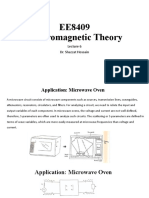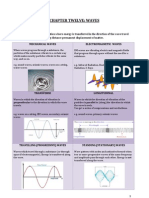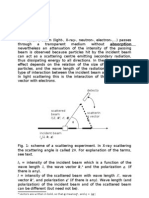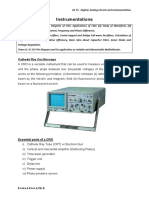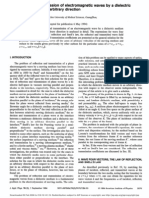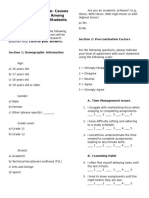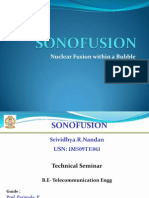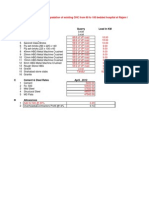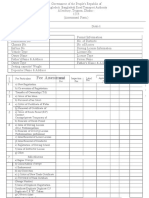The Electromagnetic Field Theory Ii Wave Polarization: Dr. A. Bhattacharya
The Electromagnetic Field Theory Ii Wave Polarization: Dr. A. Bhattacharya
Uploaded by
Micro EmissionCopyright:
Available Formats
The Electromagnetic Field Theory Ii Wave Polarization: Dr. A. Bhattacharya
The Electromagnetic Field Theory Ii Wave Polarization: Dr. A. Bhattacharya
Uploaded by
Micro EmissionOriginal Description:
Original Title
Copyright
Available Formats
Share this document
Did you find this document useful?
Is this content inappropriate?
Copyright:
Available Formats
The Electromagnetic Field Theory Ii Wave Polarization: Dr. A. Bhattacharya
The Electromagnetic Field Theory Ii Wave Polarization: Dr. A. Bhattacharya
Uploaded by
Micro EmissionCopyright:
Available Formats
THE ELECTROMAGNETIC FIELD
THEORY II
WAVE POLARIZATION
Dr. A. Bhattacharya
1
Pol ar i zat i on
2
Pol ar i zat i on
3
The orientation of the Electric and the Magnetic field
vectors define the polarization of the propagating wave
The polarization of the propagating wave are not strictly
important in terms of the propagation of radiation in free
space
When radiation strikes the ground the response of the
surface material can be different for different orientation
of the vectors
Need a convention to describe the direction in which
the field vectors point
Pol ar i zat i on
4
Pol ar i zat i on
5
Note that the perpendicular polarized wave is horizontal
to the Earths surface
In RS it is therefore more often called horizontal
polarization
Not strictly correct, parallel polarization is similarly
referred to as vertical polarization
The plane of polarization is that in which the Electric
field vector oscillates sinusoidally
Pol ar i zat i on
6
difference Phase
Pol ar i zat i on
7
The plot shows two components of the Electric field as
functions of time at a given position in space to illustrate
the significance of the phase difference
Pol ar i zat i on
8
Pure circular polarization only occurs when the two
components have the same amplitude and the phase
difference between them is 90
In the most general case the approaching wave would
be an ellipse
There will be left-elliptical polarization and right-
elliptical polarization depending on the sign of the phase
angle between the components
Circular (phase= 90) and linear polarization (phase= 0)
are special cases. Their relative amplitudes will
determine the orientation of the actual field vector
Pol ar i zat i on
9
0 =
=
h v
a a / = Slope
h v
a a / = Slope
Pol ar i zat i on
10
Two properties of the ellipse relate directly to the
polarization state of the radiation
Ellipticity or Eccentricity () which describes how
different it is from a circle or a straight line
Tilt ( ) or inclination with respect to the horizontal
This shows the explicit relationships between
properties of the wave and those of the
polarization ellipse
( ) , ,
v h
a a
( ) ,
Pol ar i zat i on (Jones Vec t or )
11
Another way of expressing the Electric field is by using
the parameters of polarization ellipse
A Amplitude
Absolute phase
corresponding to jR resulting
from propagation path
E
j
Jones vector
The exponential factor in time is
dropped since it applies to all
fields
Pol ar i zat i on (Jones Vec t or )
12
j e
j
=
= = =
0 if 90
We can absorb the sign into
eccentricity
correspond to left elliptical
polarization
sin j +
Pol ar i zat i on (Jones Vec t or )
13
We can transform the vector so that it applies to more
general case of the inclined ellipse by rotating the axes
clockwise by the inclination angle
The Electric field vector in
the most general case
Pol ar i zat i on (Jones Vec t or )
14
Some common
Jones vectors
Pol ar i zat i on (Jones Vec t or )
15
Circular polarization as a basis vector system
We have considered a travelling wave as a combination
of horizontal and vertical components
It is possible to choose right circularly polarized and
left circularly polarized fields components as the
basis
The unit vectors and are unit vectors rotate
around the unit circle in their respective directions
carrying the relevant field magnitude with them
Pol ar i zat i on (Jones Vec t or )
16
Purely left circular polarization wave will have E
R
=0
The horizontal and vertical field have the same
amplitude and the vertical component leads
has a positive phase angle of 90
0
The magnitudes are assumed to be unity and E
l
will
have the same dependence on time and position as its
two components
which can be removed as a common factor
Since and are unit vectors
Pol ar i zat i on (Jones Vec t or )
17
In a similar manner a right circularly polarized wave will
have its unit vector
Pol ar i zat i on (Jones Vec t or )
18
In matrix form :
This indicates how the linear fields can be computed
from the circular components
The circular components in terms of the linear
components
Pol ar i zat i on (Jones Vec t or )
19
A horizontal polarized wave is made up of right and left
circularly polarized waves starting in phase (and contra-
rotating)
A vertical polarized wave is made up of the two contra-
rotating starting in anti-phase
The j is a time phase term common to both components
advancing them by 90
0
Pol ar i zat i on (St okes Vec t or )
20
Stokes parameters provide a very convenient means to
describe the power density relationships in an EM wave
in radar
For a single frequency signal (monochromatic) Stokes
parameters are defined as
Pol ar i zat i on (St okes Vec t or )
21
S
0
The amplitude squared or intensity of the actual
field vector. It is directly proportional to the power
density being carried by the wave
S
1
This indicates whether the wave is more
horizontally than vertically polarized
S
2
& S
3
Indicate the ellipticity of the waves
polarization
If we have linear polarization and S
3
=0
If S
2
=0 and the polarization ellipse will aligned
vertically or horizontally
It will be circular if the magnitudes of the vertical and
horizontal components are also equal
0 =
0
90 =
Pol ar i zat i on (St okes Vec t or )
22
Complex phasor
representation
Representation in
terms of principle
angles of the
polarization ellipse
Relative phase
representation
Pol ar i zat i on (St okes Vec t or )
23
The Stokes vector can be represented in different forms
represented as:
Coherency vector
Pol ar i zat i on (St okes Vec t or )
Quest i on ?
24
Is the absolute phase ( ) or ( ) preserved in Stokes
vector representation of waves ?
x
Pol ar i zat i on (St okes Vec t or )
Quasi -monoc hr omat i c and Par t i al l y pol ar i zed waves
25
In Synthetic Aperture Radar (SAR) remote sensing the
wave is transmitted in a narrowband
The transmitted and received waves are narrowband
about the central frequency
The wave may still be interpreted as a plane wave is
said to be quasi-monochromatic
Pol ar i zat i on (St okes Vec t or )
Quasi -monoc hr omat i c and Par t i al l y pol ar i zed waves
26
The components and of the real vector is
Mean frequency
Mean wave vector
Slowly varying in comparison
with the periodic term
1
E
2
E ) (E 9
)) ( cos( ) ( ) , (
)) ( cos( ) ( ) , (
t z k t t a t z E
t z k t t a t z E
y y y
x x x
+ =
+ =
k
) ( ), ( ), ( ), ( t t t a t a
y x y x
) exp( t j
Pol ar i zat i on (St okes Vec t or )
Quasi -monoc hr omat i c and Par t i al l y pol ar i zed waves
27
The receiving antenna measures the target scattered
narrowband wave during an interval of time (Azimuth
integration time)
If
The wave then behaves in the time interval like a
monochromatic wave with mean frequency
The Jones vector or the Stokes vector can be used to
characterize the polarization of the monochromatic wave
that is said to be a completely polarized wave
T
( )
constant Assumed and
time coherence Target
<
) ( ), ( ), ( ), ( t t t a t a
T
y x y x
Pol ar i zat i on (St okes Vec t or )
Quasi -monoc hr omat i c and Par t i al l y pol ar i zed waves
28
For a longer time interval the Electric field
components and the phases are time varying
Wave is partially polarized
In this case the parameters that characterizes the
polarization wave should be time averaged
The correlation between the time Electric field
components is necessary to characterize partially
polarized waves Coherency matrix measurement
T
y x
a a ,
y x
,
)
`
conditions ergodic
and ty stationari sense - wide signal of condition the Under
?
Pol ar i zat i on (St okes Vec t or )
Quasi -monoc hr omat i c and Par t i al l y pol ar i zed waves
29
Pol ar i zat i on (St okes Vec t or )
Quasi -monoc hr omat i c and Par t i al l y pol ar i zed waves
30
Pol ar i zat i on (St okes Vec t or )
Quasi -monoc hr omat i c and Par t i al l y pol ar i zed waves
31
Pol ar i zat i on (St okes Vec t or )
Quasi -monoc hr omat i c and Par t i al l y pol ar i zed waves
32
Pol ar i zat i on (St okes Vec t or )
Quasi -monoc hr omat i c and Par t i al l y pol ar i zed waves
33
Pol ar i zat i on (St okes Vec t or )
Quasi -monoc hr omat i c and Par t i al l y pol ar i zed waves
34
A partially polarized wave can also be related to the
elements of the coherency matrix
There is a one-to-one correspondence between the
coherency matrix and the Stokes vector
Pol ar i zat i on (St okes Vec t or )
Quasi -monoc hr omat i c and Par t i al l y pol ar i zed waves
35
Radar energy backscattered from landscape will often
be polarized
If the scattering is from random scattering media or
time-varying scatterers the wave will be either partially
polarized or completely unpolarized
For a totally unpolarized wave the two amplitudes
fluctuates randomly without any relationship between
them Amplitude variation is uncorrelated
The relative phase between the components would be
totally random
Pol ar i zat i on (St okes Vec t or )
Quasi -monoc hr omat i c and Par t i al l y pol ar i zed waves
36
Pol ar i zat i on (St okes Vec t or )
Quasi -monoc hr omat i c and Par t i al l y pol ar i zed waves
37
Pol ar i zat i on (St okes Vec t or )
Quasi -monoc hr omat i c and Par t i al l y pol ar i zed waves
38
Pol ar i zat i on (St okes Vec t or )
Poi nc ar e Spher e Repr esent at i on
39
A very interesting
geometric representation of
the Stokes parameters and
the state of polarization of a
wave emerges from
Equation of a sphere in the
coordinate space
3 2 1
, , s s s
Pol ar i zat i on (St okes Vec t or )
Poi nc ar e Spher e Repr esent at i on
40
The sphere has radius of and its surface is the locus
of all possible polarization states.
The polarization of a wave can be described by the
amplitudes of its two orthogonal components and
and their relative phase
The polarization of a wave can alternatively be also
described by the angles of the polarization ellipse and
and the wave intensity
0
s
H
a
V
a
0
s
Pol ar i zat i on (St okes Vec t or )
Poi nc ar e Spher e Repr esent at i on
41
Pol ar i zat i on (St okes Vec t or )
Poi nc ar e Spher e Repr esent at i on
42
Pol ar i zat i on (St okes Vec t or )
Poi nc ar e Spher e Repr esent at i on
43
For partially polarized wave the point lies inside the
sphere
The origin represents the case of unpolarized radiation
You might also like
- Shell Boilers: BSI Standards PublicationDocument43 pagesShell Boilers: BSI Standards PublicationWael MaatougNo ratings yet
- MIT Lockpicking GuideDocument49 pagesMIT Lockpicking GuideNarrowPathPilgrim100% (10)
- Introduction To Light: Chapter 1, Light Propagation in MediaDocument58 pagesIntroduction To Light: Chapter 1, Light Propagation in MediaLee Kar HuoNo ratings yet
- Polarization WavesDocument37 pagesPolarization WavesNil TaiiayNo ratings yet
- Antenna FundamentalsDocument54 pagesAntenna FundamentalsMahmoudYasienMashhourNo ratings yet
- Interaction of Light and Matter: 8.1 Electromagnetic Waves at An InterfaceDocument34 pagesInteraction of Light and Matter: 8.1 Electromagnetic Waves at An InterfaceWilson Aponte HuamantincoNo ratings yet
- Plane Wave: ApplicationsDocument2 pagesPlane Wave: Applicationsalokesh1982No ratings yet
- Optical Resonators: Michael KossinDocument5 pagesOptical Resonators: Michael KossinMichael KossinNo ratings yet
- Optical Fibers: Structures, Waveguiding & FabricationDocument49 pagesOptical Fibers: Structures, Waveguiding & FabricationMonika SinghNo ratings yet
- Wave OptDocument13 pagesWave OptEdney MeloNo ratings yet
- Antenna FundamentalsDocument54 pagesAntenna Fundamentalshmalrizzo469No ratings yet
- Optical Fibers: Structures, Optical Fibers: Structures, Waveguiding & FabricationDocument99 pagesOptical Fibers: Structures, Optical Fibers: Structures, Waveguiding & FabricationNung NingNo ratings yet
- Rohini 97661964437Document9 pagesRohini 97661964437aswinvirat84No ratings yet
- Interpretation of Transverse Tune Spectra in A Heavy-Ion Synchrotron at High IntensitiesDocument14 pagesInterpretation of Transverse Tune Spectra in A Heavy-Ion Synchrotron at High Intensitiescampal123No ratings yet
- Week 6Document20 pagesWeek 6EngAya R ElmetwallyNo ratings yet
- Frame Dragging With Optical VorticesDocument13 pagesFrame Dragging With Optical VorticesJames StrohaberNo ratings yet
- EE8409 Electromagnetic Theory: Dr. Shazzat HossainDocument22 pagesEE8409 Electromagnetic Theory: Dr. Shazzat HossainMd Shazzat HossainNo ratings yet
- Physics Notes Chapter 12 - WavesDocument18 pagesPhysics Notes Chapter 12 - WavesMohammed RaghibNo ratings yet
- Plugin PolarizeDocument13 pagesPlugin PolarizeDipu DesperadoNo ratings yet
- Jjap 55 7S1 07KC07Document35 pagesJjap 55 7S1 07KC07Iman EffendyNo ratings yet
- Discussion On Electromagnetic Waves Under The Circumstances of Total Internal Reflection and Optical TunnelingDocument6 pagesDiscussion On Electromagnetic Waves Under The Circumstances of Total Internal Reflection and Optical TunnelingJulio CaceresNo ratings yet
- Antenna A Notes 1Document19 pagesAntenna A Notes 1spgmaniarunagiriNo ratings yet
- Eee 307 NoteDocument7 pagesEee 307 NoteeeeianemrulNo ratings yet
- Kennelly Aurthur Vector Power in Alternating Current CircuitsDocument35 pagesKennelly Aurthur Vector Power in Alternating Current CircuitskanofskiNo ratings yet
- Waves and ThermodynamicsDocument20 pagesWaves and Thermodynamicssiddhartha2862No ratings yet
- Physics Project (MAIN)Document16 pagesPhysics Project (MAIN)Akash NarayanNo ratings yet
- Advanced Radar Polarimetry Tutorial: 1.1 Introduction To EM Waves and Their PropertiesDocument97 pagesAdvanced Radar Polarimetry Tutorial: 1.1 Introduction To EM Waves and Their PropertiesValentina DiamanteNo ratings yet
- Lecture4 PDFDocument7 pagesLecture4 PDFAnkan GayenNo ratings yet
- 5 Application of Complex Number in Marine Engineering FieldDocument19 pages5 Application of Complex Number in Marine Engineering Fieldainul sufiahNo ratings yet
- Classical LaserDocument14 pagesClassical Laseratwow001No ratings yet
- WavesDocument30 pagesWavesExotic EagleNo ratings yet
- EM Wave Propagation and PolarisationDocument13 pagesEM Wave Propagation and PolarisationSurya Prakash Singh100% (1)
- Spectroscopic Techniques - XRDDocument18 pagesSpectroscopic Techniques - XRDRitik raj mehraNo ratings yet
- PolarizationDocument26 pagesPolarizationArijit SinghNo ratings yet
- Light ScatteringDocument10 pagesLight ScatteringAndri HanryansyahNo ratings yet
- Polarization: Dipartimento Di Fisica Universita' Della Calabria Corso Di Laurea Magistrale in Fisica A.A. 2017/2018Document9 pagesPolarization: Dipartimento Di Fisica Universita' Della Calabria Corso Di Laurea Magistrale in Fisica A.A. 2017/2018Diego Blady HaroNo ratings yet
- Fisika Zat PadatDocument7 pagesFisika Zat Padatabdul karim syahbaniNo ratings yet
- Instrumentations: Cathode Ray OscilloscopeDocument9 pagesInstrumentations: Cathode Ray OscilloscopeFavourite MoviesNo ratings yet
- ECNG3022 (EE30C) 2007-2008 Exam Solutions: Ideal ConductorsDocument11 pagesECNG3022 (EE30C) 2007-2008 Exam Solutions: Ideal ConductorsSami DeorajNo ratings yet
- PHS 231 CompiledDocument91 pagesPHS 231 Compiledzabraham747No ratings yet
- RJF MergedDocument29 pagesRJF MergedvardankarkiNo ratings yet
- Konstantin Y. Bliokh Et Al - Coriolis Effect in Optics: Unified Geometric Phase and Spin-Hall EffectDocument4 pagesKonstantin Y. Bliokh Et Al - Coriolis Effect in Optics: Unified Geometric Phase and Spin-Hall EffectYamcsaNo ratings yet
- Circular Motion & Oscillations: R MV FDocument8 pagesCircular Motion & Oscillations: R MV FRyantyler13No ratings yet
- Einzel LensDocument18 pagesEinzel Lenscomunian1No ratings yet
- Electromagnetic Waves in Plasma PhysicsDocument18 pagesElectromagnetic Waves in Plasma PhysicsSaidAbdullah360No ratings yet
- Pumping Electrons: Condensed Matter PhysicsDocument4 pagesPumping Electrons: Condensed Matter PhysicsCristiano BruschiniNo ratings yet
- Lecture 5Document7 pagesLecture 5sivamadhaviyamNo ratings yet
- A Simplified Approach To Synchrotron RadiationDocument8 pagesA Simplified Approach To Synchrotron RadiationFaisal AmirNo ratings yet
- Polar EigenstatesDocument11 pagesPolar EigenstatesPeter MuysNo ratings yet
- Sagnac Effect in Fiber GyroscopesDocument3 pagesSagnac Effect in Fiber GyroscopesRamiro Zakate ContrerasNo ratings yet
- Yao-Xiong Huang: of ofDocument7 pagesYao-Xiong Huang: of ofAnubhav LalNo ratings yet
- Motion of Charged Particles in Electric and Magnetic FieldsxDocument33 pagesMotion of Charged Particles in Electric and Magnetic FieldsxRam Krishna100% (1)
- Optical Sensing Techniques and Signal Processing-3Document68 pagesOptical Sensing Techniques and Signal Processing-3SB AmaleshNo ratings yet
- Light ScatteringDocument10 pagesLight ScatteringLuc LeNo ratings yet
- Magnetic Materials PDFDocument22 pagesMagnetic Materials PDFkatragaddakavitha123No ratings yet
- Chapter 4 Moving Charges and FieldDocument19 pagesChapter 4 Moving Charges and FieldSANDRONo ratings yet
- Electronic Spectroscopy Part 1Document27 pagesElectronic Spectroscopy Part 1jamesNo ratings yet
- PHYS 5583 (E & M Ii) FinalDocument4 pagesPHYS 5583 (E & M Ii) FinalwmhammerNo ratings yet
- Introduction To Molecular SpectrosDocument13 pagesIntroduction To Molecular Spectrosapi-250366166No ratings yet
- Myers InterfDocument18 pagesMyers InterfAnonymous FGY7goNo ratings yet
- EC432 Ch3 Electromagnetic Mode TheoryDocument6 pagesEC432 Ch3 Electromagnetic Mode TheoryTakashi SuohNo ratings yet
- Intensity of Electromagnetic Waves as a Function of Frequency, Source Distance and Aperture AngleFrom EverandIntensity of Electromagnetic Waves as a Function of Frequency, Source Distance and Aperture AngleNo ratings yet
- ECET 105 Week 7 Lab Project Detailed DirectionsDocument14 pagesECET 105 Week 7 Lab Project Detailed DirectionsMicro EmissionNo ratings yet
- Ee122 Freq Resp RevnotesDocument6 pagesEe122 Freq Resp RevnotesMicro EmissionNo ratings yet
- 8 Additional MaterialsDocument32 pages8 Additional MaterialsMicro EmissionNo ratings yet
- Courseinfo OldDocument12 pagesCourseinfo OldMicro EmissionNo ratings yet
- Creating Custom MOSFETs With MultisimDocument5 pagesCreating Custom MOSFETs With MultisimMicro EmissionNo ratings yet
- Capacitors Demystified Ee133Document6 pagesCapacitors Demystified Ee133Micro EmissionNo ratings yet
- Guest House ListDocument1 pageGuest House ListAmit Patel56% (9)
- Will Be Long, But Worth It: Haysi Revitalization ProcessDocument2 pagesWill Be Long, But Worth It: Haysi Revitalization ProcessMatt OwensNo ratings yet
- Manual de Operacion Controlador Digital EstufaDocument1 pageManual de Operacion Controlador Digital EstufajosephNo ratings yet
- Survey QuestionnaireDocument3 pagesSurvey Questionnairedenmarkgenesisreroma1234567890No ratings yet
- HCF4060B 14-Stage Ripple Carry Binary Counter/divider and OscillatorDocument9 pagesHCF4060B 14-Stage Ripple Carry Binary Counter/divider and OscillatorSherif EltoukhiNo ratings yet
- Tugas 3 Bahasa InggrisDocument5 pagesTugas 3 Bahasa Inggrissitifariika154No ratings yet
- 2022 01 01 Honors World PoliticsDocument9 pages2022 01 01 Honors World PoliticsPaul MusgraveNo ratings yet
- SonofusionDocument29 pagesSonofusionglucifer100% (1)
- G71 O.D./I.D. Stock Removal Cycle (Group 00) : Page 1 of 3 PagesDocument3 pagesG71 O.D./I.D. Stock Removal Cycle (Group 00) : Page 1 of 3 PagesGaurav BagadeNo ratings yet
- Hofmann2011 - A Review of Decision Support Models For Offshore Wind Farms With An Emphasis On Operation and Maintenance StrategiesDocument16 pagesHofmann2011 - A Review of Decision Support Models For Offshore Wind Farms With An Emphasis On Operation and Maintenance StrategiesChrisNo ratings yet
- Eba 8y0054634a en 290923Document14 pagesEba 8y0054634a en 290923David CochlinNo ratings yet
- Learning Experiences - English Phonetic and Phonology. Portfolio 2Document8 pagesLearning Experiences - English Phonetic and Phonology. Portfolio 2LADY MADELEY SOLIS CAMPOVERDENo ratings yet
- Answer 4Document3 pagesAnswer 4Hezekiah AtindaNo ratings yet
- Piston Assembly, Skirt and Ring RTA-72Document6 pagesPiston Assembly, Skirt and Ring RTA-72rafaelNo ratings yet
- Course Out Line Management Practices and TheoryDocument4 pagesCourse Out Line Management Practices and TheoryGirma NegashNo ratings yet
- Unit 3 - Unit 4Document33 pagesUnit 3 - Unit 4Navneet Vishnoi0% (1)
- MC14066B Quad Analog Switch/Quad Multiplexer: Marking DiagramsDocument12 pagesMC14066B Quad Analog Switch/Quad Multiplexer: Marking DiagramsJoão Pedro Almeida100% (1)
- Design, Construction, Performance and Heat Extraction Studies of A Full Scale Non-Convecting Solar PondDocument33 pagesDesign, Construction, Performance and Heat Extraction Studies of A Full Scale Non-Convecting Solar PondAnuragSh1994No ratings yet
- Data 2011-12Document150 pagesData 2011-12forlogin18No ratings yet
- Experimental Evaluation of e MMC Data RecoveryDocument11 pagesExperimental Evaluation of e MMC Data RecoveryRémi GilliotNo ratings yet
- 5129 Physics Section 3KDocument85 pages5129 Physics Section 3Kpkaende4No ratings yet
- Academic Bulletin 2021-22Document440 pagesAcademic Bulletin 2021-22Vashistha GargNo ratings yet
- Field Study 1: Learning Episode FS1 14Document10 pagesField Study 1: Learning Episode FS1 14Mikee Galla100% (2)
- Assessment: Name of Circle/ZoneDocument1 pageAssessment: Name of Circle/Zoneছোট কাব্যNo ratings yet
- Axie Infinity TrackerDocument25 pagesAxie Infinity TrackerZachary Tristan MercadoNo ratings yet
- Plant Deodorizer-MSDS 6.8Document5 pagesPlant Deodorizer-MSDS 6.8POEM HUBNo ratings yet
- Ggkey DNDJ576CCGQDocument3 pagesGgkey DNDJ576CCGQvictor2472004No ratings yet
- Datasheet P198-ZH245Document3 pagesDatasheet P198-ZH245jiayi.zhong2018No ratings yet
- Hydraulic Syringe Hand ProjectDocument15 pagesHydraulic Syringe Hand ProjectUx AhmeNo ratings yet
















